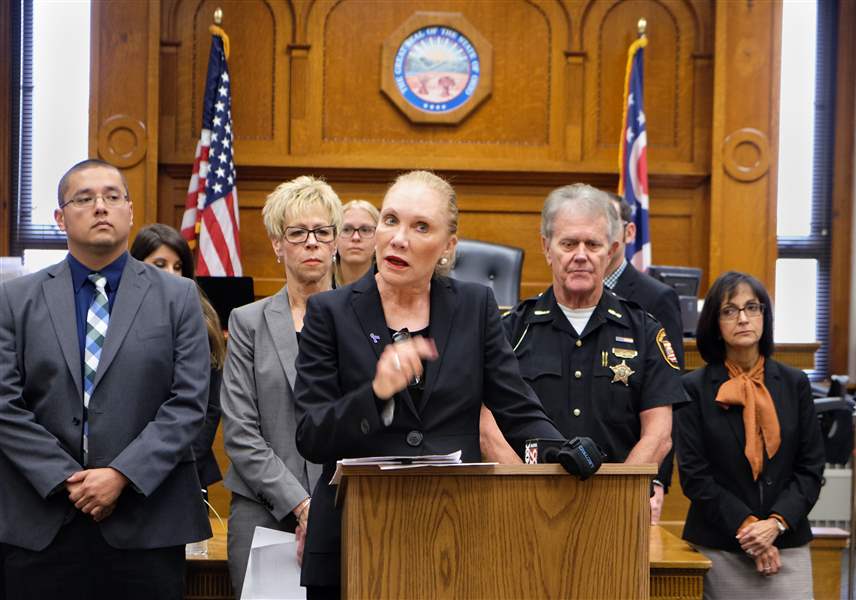
Law enforcement leaders: Issue One would tie our hands
10/11/2018
Lucas County Prosecutor Julia Bates speaks against Issue One at the press conference.
THE BLADE/JETTA FRASER
Buy This Image
Lucas County law enforcement leaders are taking a united stance against a ballot issue that would reduce penalties for nonviolent drug offenders, arguing the constitutional amendment would undermine the courts and eliminate consequences for drug users.
Area officials gathered Thursday at the courthouse to announce their opposition of Issue One, which would would turn current nonviolent fourth and fifth-degree drug felonies into misdemeanors — essentially to the equivalent of minor traffic violations. If passed, it would also enable the immediate release of as many as 10,000 felony offenders, officials said.
Lucas County Prosecutor Julia Bates, Common Pleas Judge Linda Jennings, and Sheriff John Tharp were among the community leaders
One of the goals of the amendment is to reduce prison sentences and population. According to Policy Matters Ohio, drug possession convictions accounted for 11.7 percent of the state’s prison sentences in 2014.
But local leaders said Thursday that Issue One is not the way to go and call it a “probation without consequence approach.”
“Opening the doors and saying, ‘Everybody come on home,’ with no ramifications of how to behave when you come home isn’t the answer,” Mrs. Bates said. “We are bright, we are wise, we have experts in all of the fields that this embraces. We ought to be able to come up with something that cuts down on population in the prison without releasing people that maybe shouldn’t be released.”
WATCH: Prosecutor Julia Bates on the need for stiff penalties in drug cases
For example, they questioned whether someone who possess up to 20 grams of fentanyl should be charged with a misdemeanor and exclude prison as a sentence on the first two offenses in 24 months.
A fatal dose of synthetic fentanyl is 2 milligrams, officials reported. It can also be absorbed through touching or breathing it in, as seen with a Toledo police officer who recently overdosed on a substance that went airborne in her cruiser.
In that incident, Toledo police Officer Lisa Fauver administered naloxone to herself and called for help over the radio. She was taken to Mercy Health St. Vincent Medical Center.
What’s unknown is how someone would be charged for selling a fatal dose of a dangerous drug, said Lucas County Common Pleas Court Administrative Judge Gene Zmuda.
Judge Jennings said the Common Pleas Court Judges Association, which represents 2,500 judges in Ohio, is also opposed to Issue One. Judge Jennings is the president of the association.
“It will undermine the criminal justice system and will be devastating to the State of Ohio. The amendment will undermine the current effective forms of treatment in the criminal justice system and the ability to enforce treatment,” Judge Jennings said. “Our drug courts, our drug courts throughout Ohio ... they will be decimated, they will no longer be in existence because common pleas court will no longer handle drug court.”
In addition, the 10 Lucas County Common Pleas Court judges unanimously voted to oppose it, Judge Zmuda said, adding there are significant issues raised based on the language in the constitutional amendment.
Another argument against Issue One is that it ties judges’ hands by preventing them from sending offenders to prison, Judge Jennings said. Probation violations will also have no additional consequences.
While Judge Jennings said most judges do not wish to send people to prison, sometimes it's important to have that consequence hanging over someone's head.
“Judges put people on community control to incentivize them to perform and achieve rehabilitation,” Judge Zmuda said.
A proponent of Issue One, President of the NAACP Ray Wood said Thursday most people do not wake up one day and wish to be addicted to drugs.
“We just think the overall picture is we’re doing the best that we can to help folks and give them opportunities as opposed to throwing the book at them and not be understanding,” Mr. Wood said. “One in four people have that issue, just think of how many homes, how many communities. If we can just try to put our civil hat on.”
Since the county’s Drug Abuse Response Team's inception, officers have responded to more than 4,300 overdose incidents, but there's about an 80 percent success rate of getting individuals into treatment, Sheriff Tharp said.
One thing proponents and opponents of Issue One agree on is that treatment is key for those struggling with addiction.
Proponents project $100 million would be saved annually by keeping nonviolent people out of prison, a move they argue would allow more people further access to higher wage jobs they otherwise would be barred from because of felony convictions.
Contact Allison Dunn at adunn@theblade.com, 419-213-2134 or on Twitter @AllisonDBlade.